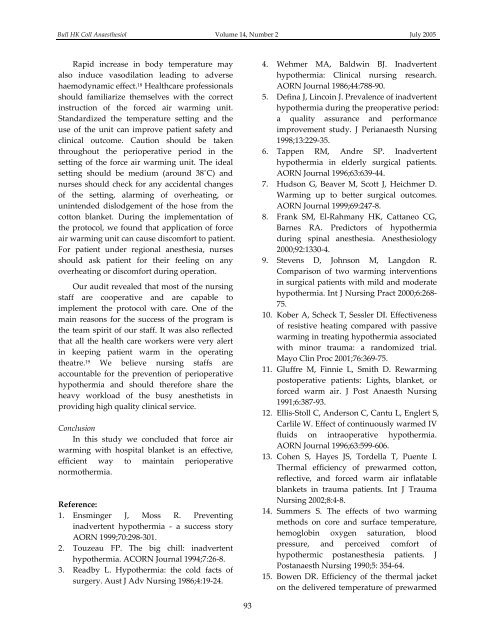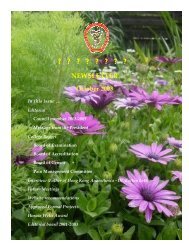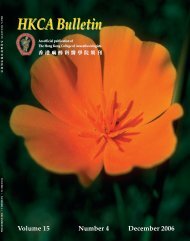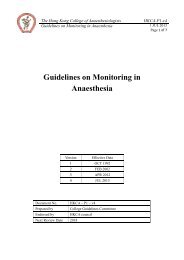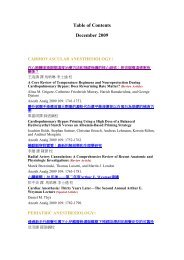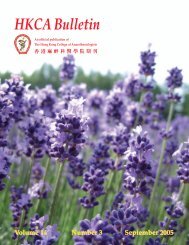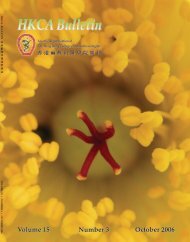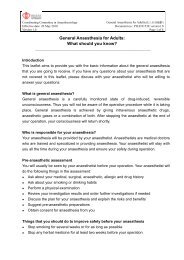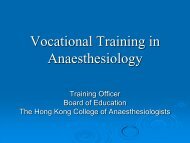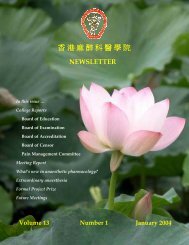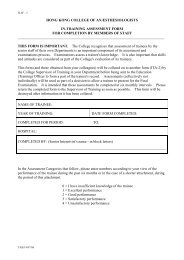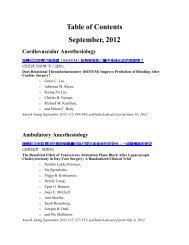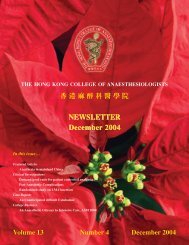July 2005 - The Hong Kong College of Anaesthesiologists
July 2005 - The Hong Kong College of Anaesthesiologists
July 2005 - The Hong Kong College of Anaesthesiologists
Create successful ePaper yourself
Turn your PDF publications into a flip-book with our unique Google optimized e-Paper software.
Bull HK Coll Anaesthesiol Volume 14, Number 2 <strong>July</strong> <strong>2005</strong>Rapid increase in body temperature mayalso induce vasodilation leading to adversehaemodynamic effect. 18 Healthcare pr<strong>of</strong>essionalsshould familiarize themselves with the correctinstruction <strong>of</strong> the forced air warming unit.Standardized the temperature setting and theuse <strong>of</strong> the unit can improve patient safety andclinical outcome. Caution should be takenthroughout the perioperative period in thesetting <strong>of</strong> the force air warming unit. <strong>The</strong> idealsetting should be medium (around 38˚C) andnurses should check for any accidental changes<strong>of</strong> the setting, alarming <strong>of</strong> overheating, orunintended dislodgement <strong>of</strong> the hose from thecotton blanket. During the implementation <strong>of</strong>the protocol, we found that application <strong>of</strong> forceair warming unit can cause discomfort to patient.For patient under regional anesthesia, nursesshould ask patient for their feeling on anyoverheating or discomfort during operation.Our audit revealed that most <strong>of</strong> the nursingstaff are cooperative and are capable toimplement the protocol with care. One <strong>of</strong> themain reasons for the success <strong>of</strong> the program isthe team spirit <strong>of</strong> our staff. It was also reflectedthat all the health care workers were very alertin keeping patient warm in the operatingtheatre. 19 We believe nursing staffs areaccountable for the prevention <strong>of</strong> perioperativehypothermia and should therefore share theheavy workload <strong>of</strong> the busy anesthetists inproviding high quality clinical service.ConclusionIn this study we concluded that force airwarming with hospital blanket is an effective,efficient way to maintain perioperativenormothermia.Reference:1. Ensminger J, Moss R. Preventinginadvertent hypothermia ‐ a success storyAORN 1999;70:298‐301.2. Touzeau FP. <strong>The</strong> big chill: inadvertenthypothermia. ACORN Journal 1994;7:26‐8.3. Readby L. Hypothermia: the cold facts <strong>of</strong>surgery. Aust J Adv Nursing 1986;4:19‐24.4. Wehmer MA, Baldwin BJ. Inadvertenthypothermia: Clinical nursing research.AORN Journal 1986;44:788‐90.5. Defina J, Lincoin J. Prevalence <strong>of</strong> inadvertenthypothermia during the preoperative period:a quality assurance and performanceimprovement study. J Perianaesth Nursing1998;13:229‐35.6. Tappen RM, Andre SP. Inadvertenthypothermia in elderly surgical patients.AORN Journal 1996;63:639‐44.7. Hudson G, Beaver M, Scott J, Heichmer D.Warming up to better surgical outcomes.AORN Journal 1999;69:247‐8.8. Frank SM, El‐Rahmany HK, Cattaneo CG,Barnes RA. Predictors <strong>of</strong> hypothermiaduring spinal anesthesia. Anesthesiology2000;92:1330‐4.9. Stevens D, Johnson M, Langdon R.Comparison <strong>of</strong> two warming interventionsin surgical patients with mild and moderatehypothermia. Int J Nursing Pract 2000;6:268‐75.10. Kober A, Scheck T, Sessler DI. Effectiveness<strong>of</strong> resistive heating compared with passivewarming in treating hypothermia associatedwith minor trauma: a randomized trial.Mayo Clin Proc 2001;76:369‐75.11. Gluffre M, Finnie L, Smith D. Rewarmingpostoperative patients: Lights, blanket, orforced warm air. J Post Anaesth Nursing1991;6:387‐93.12. Ellis‐Stoll C, Anderson C, Cantu L, Englert S,Carlile W. Effect <strong>of</strong> continuously warmed IVfluids on intraoperative hypothermia.AORN Journal 1996;63:599‐606.13. Cohen S, Hayes JS, Tordella T, Puente I.<strong>The</strong>rmal efficiency <strong>of</strong> prewarmed cotton,reflective, and forced warm air inflatableblankets in trauma patients. Int J TraumaNursing 2002;8:4‐8.14. Summers S. <strong>The</strong> effects <strong>of</strong> two warmingmethods on core and surface temperature,hemoglobin oxygen saturation, bloodpressure, and perceived comfort <strong>of</strong>hypothermic postanesthesia patients. JPostanaesth Nursing 1990;5: 354‐64.15. Bowen DR. Efficiency <strong>of</strong> the thermal jacketon the delivered temperature <strong>of</strong> prewarmed93


